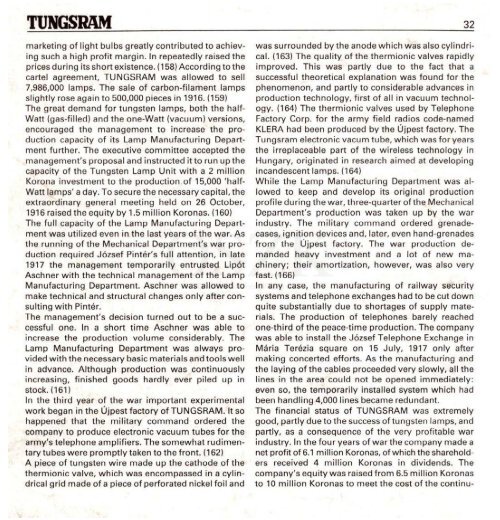THE HISTORY OF TUNGSRAM 1896-1945 - MEK
THE HISTORY OF TUNGSRAM 1896-1945 - MEK
THE HISTORY OF TUNGSRAM 1896-1945 - MEK
- No tags were found...
You also want an ePaper? Increase the reach of your titles
YUMPU automatically turns print PDFs into web optimized ePapers that Google loves.
<strong>TUNGSRAM</strong> 32marketing of light bulbs greatly contributed to achievingsuch a high profit margin. In repeatedly raised theprices during its short existence. (158) According to thecartel agreement, <strong>TUNGSRAM</strong> was allowed to sell7,986,000 lamps. The sale of carbon-filament lampsslightly rose again to 500,000 pieces in 1916. (159)The great demand for tungsten lamps, both the half-Watt (gas-filled) and the one-Watt (vacuum) versions,encouraged the management to increase the productioncapacity of its Lamp Manufacturing Departmentfurther. The executive committee accepted the"^ management's proposal and instructed it to run up thecapacity of the Tungsten Lamp Unit with a 2 millionKorona investment to the production of 15,000 'half-Watt lamps' a day. To secure the necessary capital, theextraordinary general meeting held on 26 October,1916 raised the equity by 1.5 million Koronas. (160)The full capacity of the Lamp Manufacturing Departmentwas utilized even in the last years of the war. Asthe running of the Mechanical Department's war productionrequired Jozsef Pinter's full attention, in late1917 the management temporarily entrusted LipotAschner with the technical management of the LampManufacturing Department. Aschner was allowed tomake technical and structural changes only after consultingwith Pinter.The management's decision turned out to be a successfulone. In a short time Aschner was able toincrease the production volume considerably. TheLamp Manufacturing Department was always providedwith the necessary basic materials and tools wellin advance. Although production was continuouslyincreasing, finished goods hardly ever piled up instock. (161)In the third year of the war important experimentalwork began in the Ujpest factory of <strong>TUNGSRAM</strong>. It sohappened that the military command ordered thecompany to produce electronic vacuum tubes for thearmy's telephone amplifiers. The somewhat rudimentarytubes were promptly taken to the front. (162)A piece of tungsten wire made up the cathode of thethermionic valve, which was encompassed in a cylindricalgrid made of a piece of perforated nickel foil andwas surrounded by the anode which was also cylindrical.(163) The quality of the thermionic valves rapidlyimproved. This was partly due to the fact that asuccessful theoretical explanation was found for thephenomenon, and partly to considerable advances inproduction technology, first of all in vacuum technology.(164) The thermionic valves used by TelephoneFactory Corp. for the army field radios code-namedKLERA had been produced by the Ujpest factory. TheTungsram electronic vacum tube, which was for yearsthe irreplaceable part of the wireless technology inHungary, originated in research aimed at developingincandescent lamps. (164)While the Lamp Manufacturing Department was allowedto keep and develop its original productionprofile during the war, three-quarter of the MechanicalDepartment's production was taken up by the warindustry. The military command ordered grenadecases,ignition devices and, later, even hand-grenadesfrom the Ujpest factory. The war production demandedheavy investment and a lot of new machinery;their amortization, however, was also veryfast. (166)In any case, the manufacturing of railway securitysystems and telephone exchanges had to be cut downquite substantially due to shortages of supply materials.The production of telephones barely reachedone-third of the peace-time production. The companywas able to install the Jozsef Telephone Exchange inMaria Terezia square on 15 July, 1917 only aftermaking concerted efforts. As the manufacturing andthe laying of the cables proceeded very slowly, all thelines in the area could not be opened immediately:even so, the temporarily installed system which hadbeen handling 4,000 lines became redundant.The financial status of <strong>TUNGSRAM</strong> was extremelygood, partly due to the success of tungsten lamps, andpartly, as a consequence of the very profitable warindustry. In the four years of war the company made anet profit of 6.1 million Koronas, of which the shareholdersreceived 4 million Koronas in dividends. Thecompany's equity was raised from 6.5 million Koronasto 10 million Koronas to meet the cost of the continu-








![Letöltés egy fájlban [4.3 MB - PDF]](https://img.yumpu.com/50159926/1/180x260/letaltacs-egy-fajlban-43-mb-pdf.jpg?quality=85)







